Jan 21, 2018 | Australia, Canada, coins, commentary, news
One of the more interesting news items is that the Royal Canadian Mint is suing the Royal Australian Mint.
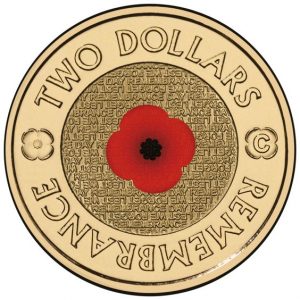
The Royal Canadian Mint alleges the Royal Australian Mint infringed on its patents when creating the 2012 Remembrance Day $2 coin.
Reports state that the two sides have tried to discuss the matter over the last two years. When no agreement had been reached, the Royal Canadian Mint decided to sue for relief. The Royal Canadian Mint is demanding that Australia hand over all 500,000 of the Remembrance Day coins struck or “destroyed under supervision.”
Since the Royal Canadian Mint is a crown corporation, it is an independent entity of the Canadian government. It has its own corporate and governance structure mandated by law. For those in the United States, it is similar to the relationship that Fannie Mae and Freddy Mac have with the United States government. On the other hand, the Royal Australian Mint is an agency in the Australian government in the same manner that the U.S. Mint is an agency in the United States government. Therefore, the Royal Canadian Mint is suing the Commonwealth of Australia.
“The applicant has suffered, and will continue to suffer, loss and damage by reason of the acts of the respondent pleaded above,” the statement of claim filed by the Royal Canadian Mint reads. Really? The Royal Canadian Mint has suffered because the Royal Australian Mint created a coin with a colored poppy for sale and distribution in Australia?
If the Royal Australian Mint infringed on the Royal Canadian Mint patent then there may be a case for relief owed for using the technology. But if the Royal Canadian Mint is trying to make a case based on the suffering of damages from sales of circulating versus commemorative coins, I think that the Royal Canadian Mint may be royally going in the wrong direction.
And now the news…

January 15, 2018
“At a time when our national debt is over $20 trillion, it is more and more difficult to find money for important things like cancer research,” – Congresswoman Carolyn Maloney.  → Read more at womensenews.org
→ Read more at womensenews.org

January 17, 2018
Online dealer sold 30kg of gold Tuesday, worth more than $1m Bitcoin tumbles below $10,000 for first time since December Amid the wild Bitcoin ride that’s wiped more than 40 percent off the cryptocurrency’s price in a month, a pattern may be emerging: sellers are switching out of digital gold and into the real thing.  → Read more at bloomberg.com
→ Read more at bloomberg.com

January 17, 2018
Gold’s liquidity and stability have made it an attractive option for investors in recent years. There are many ways to invest in gold. Investopedia lists gold futures, investing in old companies, gold EFTs, gold mutual funds, gold bullion, gold jewelry, and, of course, gold coins.  → Read more at newsmax.com
→ Read more at newsmax.com

January 17, 2018
After more than a year, visitors to the Nevada State Museum can watch the museum's historic Coin Press No. 1 carry on a mission it started nearly 150 year ago in the same building. The venerable press — which churned out millions of dollars in silver and gold coins during stints at U.S.  → Read more at nevadaappeal.com
→ Read more at nevadaappeal.com

January 18, 2018
OTTAWA — The Royal Canadian Mint is suing its Australian counterpart over the way it prints red poppies on its commemorative Remembrance Day coins. Documents filed in Australia’s Federal Court in December allege The Royal Australian Mint used without permission a printing method patented by the Canadian mint — which is now demanding that Australia’s 500,000 commemorative $2 coins, in circulation since 2012, either be turned over to them or “destroy(ed) under supervision.”  → Read more at nationalpost.com
→ Read more at nationalpost.com
Image courtesy of the Royal Australian Mint and had to be downloaded from Internet archives since it was deleted from their website.
Feb 13, 2014 | Australia, coin design, coins, commentary, nclt
Whenever I comment on using design elements on coins that do not involve engraving I am reminded that one person’s gimmick is another’s innovation. I am also reminded that I have demonstrated a bit of hypocrisy by purchasing some of these coins for my collection including celebrating the innovation of one of these coins. So why do I have a near visceral reaction to the introduction of a coin whose purpose is to commemorate with a non-engraved design elements?
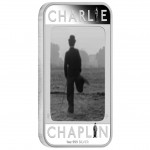
2014 Charlie Chaplin 1 oz lenticular commemorative coin from the Perth Mint
The reverse does not use just any image. It is the iconic image of the waddling tramp walking away from the camera. Like the image on the screen, this is a moving image. Using lenticular technology, the image will shift as you move the coin making it appear that Chaplin is walking.
Chaplin was the nascent movie industry’s first megastar. Although Mary Pickford and Douglas Fairbanks were the most recognizable of the time, Chaplin was the first actor whose movies were considered a success because he was involved with them. And while there were posters and booklets printed about other stars, Chaplin was the first to be fully merchandised around the world including a Chaplin doll that is one of the most prized toy and movie memorabilia collectibles today.
Even though Chaplin was the phenomenon of this time and I consider myself a fan, I am having a difficult time liking this coin.
In fact, I downright hate it!
I cannot explain why I hate this coin because I am interested in the Niue 2007 Van Gogh silver coin and the Andorra 2008 Renoir 10 Diners silver coin. All three coins are colored coins and ingot shaped, but the Chaplin coin really bothers me.
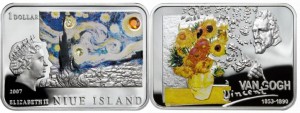
Niue Island 2007 Great Painters – Vincent Van Gogh $1 Rectangular Silver Dollar with Color and Zircon Crystal Gemstones
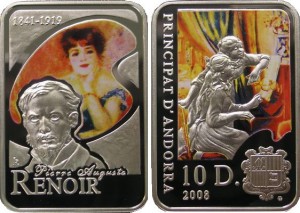
Andorra 2008 Great Painters – Pierre August Renoir 10 Diners Rectangular Silver Proof with Color
Although I did not like the Monnaie de Paris 2012 Yves Klein commemorative coin with the blue hand, I did not have this type of reaction. However, I still like the 2006 Canadian Breast Cancer commemorative and circulating quarter with enameled features.
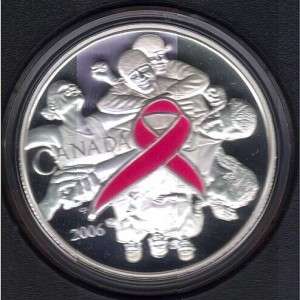
2006 Breast Cancer Silver Coin with colored pink ribbon.

2006 Breast Cancer Quarter was Canada’s first colored circulating coin
One of the differences between the colored coins that I like versus those that I do not are the ones I like do have some engraving involved. And even though I do not like the Yves Klein commemorative, I do not find it as objectionable because the blue hand is an enhancement and not the entire design on the coin.
Not counting the Somalia motorcycle and sports car coins, I seem to have this response where the coloring or design gimmick encompasses the entire design of the coin. Once the coloring or other design elements that are not engraved go beyond enhancements and are used to create the design is when I begin to object.

2007 Somalia Motorcycle Non-circulating Legal Tender Coins

2010 Somalia Sports Cars
It could also be the subject matter. As a resurgent gear-head with an eye toward the classics, the Somalia classic motorcycles and sports car coins appeal to me while the coins with colored birds and flowers do not. As the surviving spouse of a cancer victim, I supported the use of coins to raise money for cancer research by the Royal Canadian Mint, but none of the current hologram coins would interest me if they did not have the holograms.
Color and other enhancements on coins are here to stay. If there were not a market for them then the various mints would not produce these types of coins. It may be something that will attract more collectors and grow the hobby, which is good.
Maybe I should think about these enhancements like I think about cars: I want a car that drives and feels like a car and a coin that is engraved art; I do not want to drive a computer nor a coin that seems gimmicky.
Credits
- Image of the 2014 Charlie Chaplin 1-ounce lenticular silver coin courtesy of the Perth Mint.
- Images of the Van Gogh and Renoir coins courtesy of Talisman Coins.
Nov 11, 2012 | Australia, Britain, coins, history
In Flanders Fields
by John McCrae, May 1915
In Flanders fields the poppies blow
Between the crosses, row on row,
That mark our place; and in the sky
The larks, still bravely singing, fly
Scarce heard amid the guns below.
We are the Dead. Short days ago
We lived, felt dawn, saw sunset glow,
Loved and were loved, and now we lie
In Flanders fields.
Take up our quarrel with the foe:
To you from failing hands we throw
The torch; be yours to hold it high.
If ye break faith with us who die
We shall not sleep, though poppies grow
In Flanders fields.
“In Flanders Fields” was written during World War I by Lieutenant Colonel John McCrae, a Canadian physician stationed in northern France. Aside from being a physician, he was a teacher, poet, and author. McCrea was appointed as a field surgeon and was in charge of a field hospital during the Second Battle of Ypres when his friend and former student Lieutenant Alexis Helmer was killed in the battle. The death and funeral of his friend inspired McCrae to write the poem.
“In Flanders Fields” was published anonymously in the British magazine Punch on December 8, 1915. However, the index for the year printed only a few weeks later attributed the poem to McCrea. The poem became one of the most popular of the war and was extensively printed in the United States while its leaders were debated whether to join the war.
McCrae died of pneumonia on January 28, 1918 while commanding No. 3 Canadian General Hospital (McGill) at Boulogne. He was buried with full military honors at Wimereaux Cemetery near the English Channel 3 miles from Boulogne.

2004 Canada Poppy Quarter, the first colorized coin ever issued for circulation by any mint.
The remembrance poppy is not as strong a symbol in the United States since the nation did not declare war on Germany until April 1917. The American Legion has used the poppy as part of its fund raising efforts.
Maybe the United States should embrace the poppy as well. Why not create a commemorative coin with a colored poppy as the design and use the seignorage from the sales to support the work of the Department of Veterans Affairs? How about changing the reverse of the Roosevelt Dime to be a red-colored poppy to raise awareness of all our veterans? Using the Roosevelt Dime would give it a needed refresh and would tie both World Wars in one coin. Then the U.S. Mint could strike special silver dime for sale to the public.
Maybe it is an idea whose time has come.
Oct 4, 2012 | Australia, BEP, currency, Federal Reserve, policy
Last year I asked why the United States would not consider using polymer notes after the Bank of Canada made their announcement that they will transition to using the polymer substrate. Not only are polymer notes very difficult to counterfeit, they last longer reducing printing costs and overhead to both the Bureau of Engraving and Printing and the Federal Reserve.
The
Spink Auction was held on October 2, 2012 in their London offices. None of the nine Canadian test notes printed on DuraNote were sold.
After it was announced that Spink of London will auction sheets of DuraNote trial printings from the Bank of Canada, BEP told CoinWorld that they printed as many as 40,000 sheets of Federal Reserve Notes using the DuraNote substrate.
DuraNote was a product of Mobil Chemical and AGRA Vadeko of Canada. Trials of DuraNote were not successful and the project was abandoned. Patents for DuraNote were sold following the Exxon-Mobil merger.
Around the same time, the Reserve Bank of Australia (RBA) developed a polymer substrate with a different formula that went into production in 1992. Since then, Australia has been successfully printing polymer notes.
In the mean time, there continues to be issues with folding of the paper specially designed for the new $100 Federal Reserve Note. Since the October 1, 2010 announcement by the Fed of the folding issue, the Fed and BEP has less than forthcoming on the status of the new note including the BEP withholding their annual report for fiscal year 2011 so they do not have to disclose how many of these notes they have in inventory.
The paper being used by the BEP is manufactured by Crane & Company who has had the exclusive contract with the BEP since 1879.
Where DuraNote failed RBA succeeded in creating a workable technology that is being adopted world wide. With the new $100 note having printing problems, why has the BEP not looked into the RBA polymer substrate for U.S. currency? Why does the Federal Reserve, BEP, and Secret Service cling to 19th and 20th century printing technologies in the 21st century? Or is this a matter of the influence being purchased [PDF] by Crane & Company in order to maintain its monopoly.
Maybe it is time for the Fed and the BEP to re-examine their commitment to paper and stop wasting time and money with failed technologies.
Nov 19, 2008 | Australia, coins, YN
The future of the hobby we love are in our children. There has to be a way to get children interested in collecting coins beyond looking at the sameness of circulating series. We have seen that the 50 State Quarters program has had a postitive impact on the hobby. There has even been intrest in the Presidential Dollar program and the educational aspect with learning about each president.
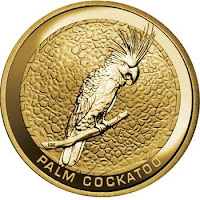 Our friends at The Perth Mint has taken this one step further. They have created a AU$1 series based on animals found in Australia. The 2008 Australian Animal $1 Coins program is being marketed to young collectors to teach them more about Australian animals. The Perth Mint has also been reaching beyond Australia to young collectors all over the world.
Our friends at The Perth Mint has taken this one step further. They have created a AU$1 series based on animals found in Australia. The 2008 Australian Animal $1 Coins program is being marketed to young collectors to teach them more about Australian animals. The Perth Mint has also been reaching beyond Australia to young collectors all over the world.
The program is a 12 coin series of $1 non-circulating legal tender coins with four coins in each of three categories of animals that live in the air, on land, and in the sea. To appeal to the young collector, The Perth Mint offers the coins on individual cards or together with an album and two different sets. The complete set includes all 12 coins, a complete album with themed games, stickers, and a medal of “Gordy the Gekko,” a mascot of The Perth Mint.
There is even a companion website that also has games for the young, or young at heart. There is a contest, but I am not sure it is something those of us who live outside of Australia can participate with. But I had fun with the word search game.
With the current exchange rate, the cost for the complete set is just under $47.00. It sounds like a good gift for the young numismatist. With the Whitman Baltimore Show coming this weekend, I will see if a dealer has a set I can buy for my niece who really likes animals. She will like it!
Image courtesy of The Perth Mint.

 → Read more at womensenews.org
→ Read more at womensenews.org → Read more at bloomberg.com
→ Read more at bloomberg.com → Read more at newsmax.com
→ Read more at newsmax.com → Read more at nevadaappeal.com
→ Read more at nevadaappeal.com → Read more at nationalpost.com
→ Read more at nationalpost.com









